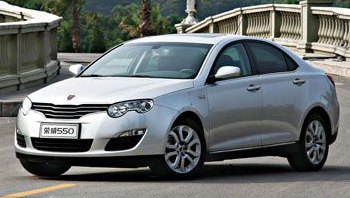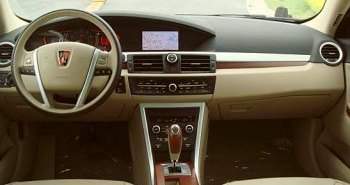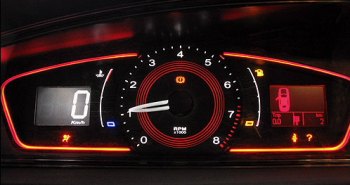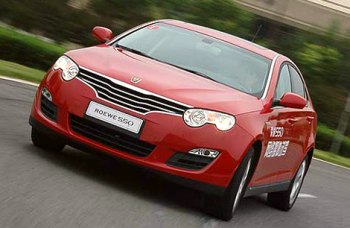|

|
The ghost of Rover 75 is revived in a
new heaven...
|
Since
MG Rover bankrupted in April 2005, the intellectual property of its
Rover 75 and K-series engine were bought by SAIC (Shanghai Automotive
Industry Corporation), the largest car maker in China. SAIC built as
many as 1.5 million vehicles in 2007 through its joint-venture with GM
and Volkswagen, but so far it has yet to develop its own passenger car.
The availability of Rover 75 platform gave it the best opportunity. Two
years ago, SAIC started producing a long wheelbase version of the car
in China. It even got a badge and a name close to the original, Roewe
750, very much in the same way as most Chinese fake goods. To the
management of SAIC, that was the beginning of a new era.
The next stage would be to develop a new car base on the Rover 75
platform. Called Roewe 550, it was conceived to be a smaller, cheaper
and more mainstream car than the 750. The problem was, SAIC did not
have the expertise and R&D facility to fulfill that task. Therefore
it hired ex-Rover engineer David Lindley as its technical director and
contracted the development work to British engineering firm Ricardo,
which had some guys worked on the original Rover. As for design, it
employed an all-British team led by Tony Williams. The Brits can
proudly claim they have built a successor to their Rover, albeit with a
Chinese name and a small print "Made in China".

|
The Brits can proudly claim they have
built a successor to their Rover, albeit with a Chinese name...
|
The
British design is certainly very successful, especially up front. It
has an elegant T-shape grille laid beautifully on the curvy nose.
Either side of which is a peanut-shape headlight that resemble the last
Rover design. The body profile is more compact than the old Rover, with
fast angle windsceen and rear screen, a wide stance and a sporty waist
line that draws towards a high-set boot. In contrast to the classical
Rover, it looks thoroughly modern. Aerodynamic drag coefficient is a
good 0.30.
The underpinning is derived from the Rover 75 platform, but the UK
engineering team altered its hard points. Wheelbase is shortened by 40
mm to 2705 mm. Overall length is shortened by 120 mm. On the other
hand, the Roewe 550 is considerably wider and taller than the old car.
Its luggage space is a competitive 452 liters.

|
The clean and solid design looks as if
made in Germany...
|
The
new body feels solid and well built like overseas products. From the
padded surfaces of the luggage compartment and the hydraulic struts
supporting boot lid, you can see SAIC is serious to make a quality
product. The interior also seems up to the job. The clean and solid
design looks as if made in Germany. The color scheme is tasteful. The
materials are decent - the black upper dash is made of soft-touch
plastic, the steering wheel and seats are trimmed with German leather,
the door handles and gearshift paddles are made of real aluminum, even
the faux alloy and wood trim would be decent on a Japanese mid-size
car. However, small details still reveal its nationality. For example,
some switch gears seem fragile, the gear stick looks cheap, the
steering wheel rims blocks the view to instrument panel etc.
The digital instrument panel is not my cup of tea, as it looks ugly and
cheap. Unfortunately, SAIC is very proud of it and even named it
"Silverstone". In the center of it is an analogue rev counter. When you
start the engine, the needle will turn one round to welcome you. At the
left side of it is a cheap digital speedometer. Right side is a small
monochrome display of trip computer. Above the center console is a
6.5-inch color LCD monitor, which is part of an upmarket infotainment
system. The latter provides satellite navigation, Hi-Fi, DVD, rear-view
camera, SD-card and Bluetooth connectivity, all are controlled through
a BMW i-Drive-like rotary switch on the center console.

|
"Silverstone" digital instrument is
not everybody's taste...
|
Because
of the long wheelbase, the cabin is roomy for four 6-footers. Roewe 550
is a big car for C-segment (e.g. Ford Focus) in which it competes. To
steal sales from foreign brands, SAIC knows it should provide more car
for less dollar, sorry, less RMB. So far this strategy seems
successful.
Performance is not a strength of Roewe 550. Its power comes
from the outdated Rover 1.8-liter K-series 16-valve four-cylinder
engines.
Ricardo re-engineered them to comply with Euro IV emission standard by
using Siemens engine management system. The naturally aspirated version
has replaced its unique Rover VVC system with a more conventional
dual-continuous variable cam phasing by German supplier
Schaeffler. Its maximum output is 133 hp at 6000 rpm and 125
lb-ft of torque at 4800 rpm, or in other words, nothing spectacular.
The
turbocharged version also came from the Rover era (it was introduced
late in the life of Rover). It pumps out 160 horsepower and 158 lb-ft
of torque. Ricardo could not increase its output any more because this
is as much as
the thin-wall K-Series 1.8 can take. Remember, this engine started life
20 years ago as 1.4-liter unit.

|
Aerodynamic drag is a good 0.30
|
As
expected, the base 1.8 lacks punch to pull the 1.4-ton Roewe 550 with
the necessary enthusiasm. The 1.8T is better. Once its turbo awake, it
provides a solid and linear pull while producing a sporty growl.
However, compare with newer generation turbocharged engines like
Volkswagen's 1.8 TSI, its turbo starts working too late and has more
noticeable turbo lag. Its fuel consumption and CO2
emission are also well behind nowaday's standard.
The Japanese-made Aisin 5-speed Tiptronic automatic transmission
provides manual shift through either paddles (mounted behind steering
wheel) or conventional gear stick. Neither are deemed to be responsive.
Mate with the 1.8 turbo engine it needs as long as 10 seconds to go
from zero to 60 mph. The gearshift is also far from seamless in auto
mode. I suspect this problem has more to do with the software matching
between the engine and the gearbox instead of the Aisin box itself.
 |
Its chassis works like a typical
European product...
|
If
you can overcome the outdated powertrain, you will be pleased with the
driving manner of Roewe 550, because its chassis works like a typical
European product. Rover 75 donated its good suspensions consisting of
MacPherson struts up front and a Z-axle (multi-link) setup at the rear
- the latter was originally developed by BMW. The suspension tuning is
firm by the standard of Chinese cars while slightly softer than most
German cars. It corners with little pitch and roll, and the chassis
feels solid. The hydraulic power steering is heavy, quick and accurate,
if not very feelsome. Should you abuse it, it will save you with
stability control, traction control, ABS and 6 air bags.
Unquestionably, Roewe 550 is a much better effort than the first
Chinese car Brilliance Zhonghua. It looks good, drives well, is solidly
built and well equipped. Only the old engines and that digital
instrument panel deny it from success. Following the merger between
SAIC and Nangjing Automobile, the former got the rights of MG brand, so
in the future we may see this car on European roads under the MG name.
|